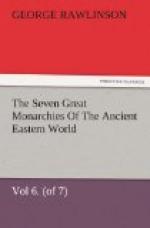It must, however, be confessed, that the tendency of the Parthians was to degenerate. Although the final blow was struck in an unexpected quarter, and perhaps surprised the victors as much as the vanquished, still it is apparent that for a considerable space before the revolt of Artaxerxes the Parthian Empire had shown signs of failing strength, and had tended rapidly towards decay and ruin. The constant quarrels among the Arsacidae and the incipient disintegration of the Empire have been noticed. It may be added here that a growing barbarism, a decline in art and letters, is observable in the Parthian remains, such as have usually been found to accompany the decrepitude of a nation. The coinage has from first to last a somewhat rude character, which indicates that it is native, and not the production of Greek artists. But on the earlier coins the type, though not indicative of high art, is respectable, and the legends are, with few exceptions, perfectly correct and classical. Barbarism first creeps in about the reign of Gotarzes, A.D. 42-51. It increases as time goes on, until, from about A.D. 133, the Greek legend upon the coins becomes indistinct and finally unintelligible, the letters being strewn about the surface of the coin, like dead soldiers over a field of battle. It is, clear that the later directors of the mint were completely ignorant of Greek, and merely attempted to reproduce on the coin some semblance of a language which neither they nor their countrymen understood. Such a condition of a coinage is almost without parallel, and indicates a want of truth and honesty in the conduct of affairs which implies deep-seated corruption. The Parthians must have lost the knowledge of Greek about A.D. 130, yet still a pretence of using the language was kept up. On the tetra-drachms—comparatively rare coins—no important mistake was committed; but on the more usual drachm, from the time of Gotarzes, the most absurd errors were introduced, and thenceforth perpetuated. The old inscription was, in a certain sense, imitated, but every word of it ceased to be legible: the old figures disappeared in an indistinct haze, and—if we except the head and name of the king (written now in a Semitic character)—the




